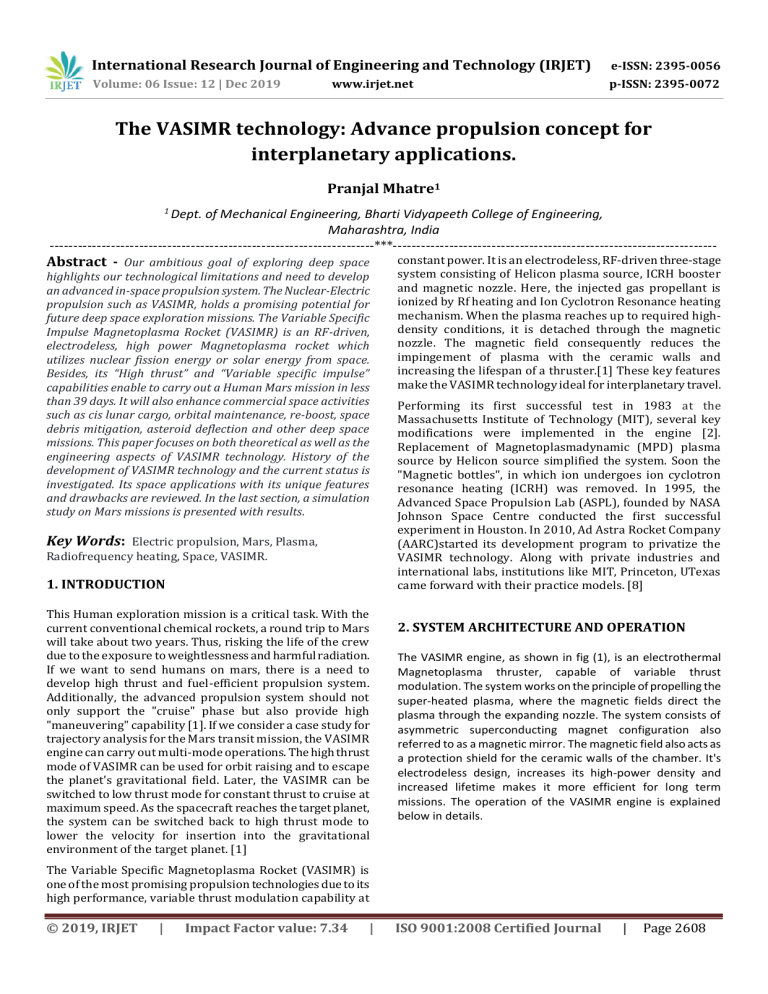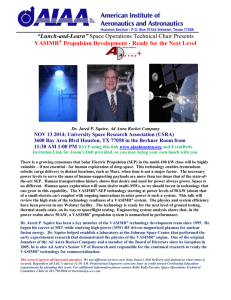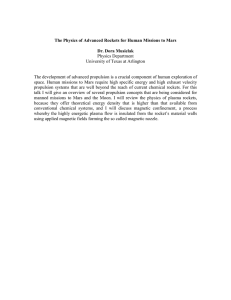VASIMR Technology: Advanced Interplanetary Propulsion
advertisement

International Research Journal of Engineering and Technology (IRJET) e-ISSN: 2395-0056 Volume: 06 Issue: 12 | Dec 2019 p-ISSN: 2395-0072 www.irjet.net The VASIMR technology: Advance propulsion concept for interplanetary applications. Pranjal Mhatre1 1 Dept. of Mechanical Engineering, Bharti Vidyapeeth College of Engineering, Maharashtra, India ---------------------------------------------------------------------***--------------------------------------------------------------------- Abstract - Our ambitious goal of exploring deep space highlights our technological limitations and need to develop an advanced in-space propulsion system. The Nuclear-Electric propulsion such as VASIMR, holds a promising potential for future deep space exploration missions. The Variable Specific Impulse Magnetoplasma Rocket (VASIMR) is an RF-driven, electrodeless, high power Magnetoplasma rocket which utilizes nuclear fission energy or solar energy from space. Besides, its “High thrust” and “Variable specific impulse” capabilities enable to carry out a Human Mars mission in less than 39 days. It will also enhance commercial space activities such as cis lunar cargo, orbital maintenance, re-boost, space debris mitigation, asteroid deflection and other deep space missions. This paper focuses on both theoretical as well as the engineering aspects of VASIMR technology. History of the development of VASIMR technology and the current status is investigated. Its space applications with its unique features and drawbacks are reviewed. In the last section, a simulation study on Mars missions is presented with results. Key Words: Electric propulsion, Mars, Plasma, Radiofrequency heating, Space, VASIMR. 1. INTRODUCTION This Human exploration mission is a critical task. With the current conventional chemical rockets, a round trip to Mars will take about two years. Thus, risking the life of the crew due to the exposure to weightlessness and harmful radiation. If we want to send humans on mars, there is a need to develop high thrust and fuel-efficient propulsion system. Additionally, the advanced propulsion system should not only support the "cruise" phase but also provide high "maneuvering" capability [1]. If we consider a case study for trajectory analysis for the Mars transit mission, the VASIMR engine can carry out multi-mode operations. The high thrust mode of VASIMR can be used for orbit raising and to escape the planet's gravitational field. Later, the VASIMR can be switched to low thrust mode for constant thrust to cruise at maximum speed. As the spacecraft reaches the target planet, the system can be switched back to high thrust mode to lower the velocity for insertion into the gravitational environment of the target planet. [1] constant power. It is an electrodeless, RF-driven three-stage system consisting of Helicon plasma source, ICRH booster and magnetic nozzle. Here, the injected gas propellant is ionized by Rf heating and Ion Cyclotron Resonance heating mechanism. When the plasma reaches up to required highdensity conditions, it is detached through the magnetic nozzle. The magnetic field consequently reduces the impingement of plasma with the ceramic walls and increasing the lifespan of a thruster.[1] These key features make the VASIMR technology ideal for interplanetary travel. Performing its first successful test in 1983 at the Massachusetts Institute of Technology (MIT), several key modifications were implemented in the engine [2]. Replacement of Magnetoplasmadynamic (MPD) plasma source by Helicon source simplified the system. Soon the "Magnetic bottles", in which ion undergoes ion cyclotron resonance heating (ICRH) was removed. In 1995, the Advanced Space Propulsion Lab (ASPL), founded by NASA Johnson Space Centre conducted the first successful experiment in Houston. In 2010, Ad Astra Rocket Company (AARC)started its development program to privatize the VASIMR technology. Along with private industries and international labs, institutions like MIT, Princeton, UTexas came forward with their practice models. [8] 2. SYSTEM ARCHITECTURE AND OPERATION The VASIMR engine, as shown in fig (1), is an electrothermal Magnetoplasma thruster, capable of variable thrust modulation. The system works on the principle of propelling the super-heated plasma, where the magnetic fields direct the plasma through the expanding nozzle. The system consists of asymmetric superconducting magnet configuration also referred to as a magnetic mirror. The magnetic field also acts as a protection shield for the ceramic walls of the chamber. It's electrodeless design, increases its high-power density and increased lifetime makes it more efficient for long term missions. The operation of the VASIMR engine is explained below in details. The Variable Specific Magnetoplasma Rocket (VASIMR) is one of the most promising propulsion technologies due to its high performance, variable thrust modulation capability at © 2019, IRJET | Impact Factor value: 7.34 | ISO 9001:2008 Certified Journal | Page 2608 International Research Journal of Engineering and Technology (IRJET) e-ISSN: 2395-0056 Volume: 06 Issue: 12 | Dec 2019 p-ISSN: 2395-0072 www.irjet.net 2.3 Magnetic Nozzle The high energetic plasma is detached at greater velocity from the magnetic nozzle with velocities greater than 50,000 m/s or 110,000 mph. [7] Along with magnetic nozzle effect, no of additional phenomena like the formation of diamagnetic current, turbulent reconnections and super Alfvenic flow add to plasma detachment from the thruster, adding more thrust. [5]. Fig 2 shows the structure of magnetic fields inside the engine and the detachment of plasma at right end. Fig – 1: Schematic of the VASIMR engine 2.1 Helicon Plasma Source The Helicon Plasma Source (HPS) is a crucial stage as it determines the amount of thrust to be produced. The HPS system injects inert propellant through the quartz tube into the cylindrical helicon chamber which is surrounded by electromagnets. The injected gas is continuously bombarded by the radiofrequency waves by helicon antenna, stripping off the electrons from the gases and induces “cold plasma” inside the chamber, flowing downstream.[3] The thrust can vary depending upon the amount of propellant injected. High propellant injection rate generates low specific impulse and high thrust, whereas, low propellant injection rate produces high specific impulse and lower thrust.[3] Various theoretical and experimental parameters of Helicon source are studied with different gases like H, He, Ar, Xe, etc. At present, the conventional helicon source has recorded a stable plasma discharge with a density range of 1018 –1019 m-3. [5] Fig – 2: Magnetic field lines structure and plasma flow at the nozzle 3. UNIQUE CHARACTERISTIC AND DRAWBACKS OF VASIMR SYSTEM 3.1 Unique Characteristics • • • • • 2.2 ICRH Booster As the plasma flowing downstream enters the Ion Cyclotron heating chamber (ICH), ICRF (Ion cyclotron range of frequency) antenna, also known as RF booster emits an ion cyclotron wave (ICW). As the wave moves downstream, the ion gyrofrequency decreases along with magnetic field strength. At the lower side of the ICRF antenna, resonance occurs between ion gyrofrequency and ion cyclotron wave frequency. In this resonating region, the rotating electric field of ICW accelerates the plasma. [5] Hence, the gyro velocity of ions is transformed into high axial velocity and thus, the super-heated plasma is propelled out through the magnetic nozzle, generating thrust. ICH chamber heats the plasma temperature to a considerable temperature of 1,000,000K (1,000,0000C) which is about 173 times the surface temperature of the Sun. [6] © 2019, IRJET | Impact Factor value: 7.34 | • • Very high-power density. The application of rf waves excites the plasma to produce power up to ~6 MW/m2 . No DC bias is applied, neither cathodes nor anodes are required. Protection of plasma-facing materials by the magnetic fields with the strength of few tesla. Specific impulse can be varied at constant power by modulation of propellant at plasma source Very efficient conversion of input power more than 75% of thrust efficiency allows more thrust in the minimum propellant. Wide range of propellant choices like H, He, Xe, Ar, Kr, Ne, etc. Solids or liquids like NH3, I2 and K Low-cost ground testing [8] 3.2 Drawbacks • • • High plasma generations led to the need for a thermal management system The high magnetic field strength can arise the problem of its interaction with onboard electronics [9] Lack of state-of-the-art technology for power generation system ISO 9001:2008 Certified Journal | Page 2609 International Research Journal of Engineering and Technology (IRJET) e-ISSN: 2395-0056 Volume: 06 Issue: 12 | Dec 2019 p-ISSN: 2395-0072 www.irjet.net 4. RESEARCH STATUS AND DEVELOPMENT Since the first experimental test conducted in 1983, VASIMR technology has undergone several modifications. In 1998, NASA's Advanced Space Propulsion Lab (ASPL) performed helicon plasma experiment on VX-10 with a helicon plasma discharge up to 10 kW and in 2002, VX-25 with a plasma discharge of 25 kW was introduced. After 3 years, ASPL developed a fully efficient new VASIMR VX-50 which showed a plasma discharge of 50 kW and max thrust of 0.5 N. It performed well with an overall “speed boost” efficiency 65% and electric efficiency of 59%. [10] In 2007, Ad Astra Rocket Company demonstrated its new model of VASIMR VX-100 engine with a test record of 100 kW.[11] In a press conference on Oct 2008, Ad Astra announced that its VX-200 is now operational. The helicon discharge of VX200 used 30 kW of power for RF waves to ionize propellant gas (Argon) and 170 kW for ion cyclotron heating (ICRH) process. This engine was operated at 200kW, solid-state DCRF power processing with 98% efficiency. [11] In Mar 2015, NASA announced $10 million awards to Ad Astra to develop a new VASIMR VX-200SS up to increase technological readiness level. Here, the SS stands for "solidstate" RF device. [14] Till Aug 2017, Ad Astra completed its 10 hours firing at constant 100 kW. In Aug 2019, Ad Astra declared that with 120 kW power, they have achieved an electrical efficiency of 97% with their new RF Power Processing Unit (PPU). Testing of the complete RF PPU system is set to complete in the next few months.[15]. A recent development in the VASIMR engine has opened up many possibilities to many potential applications In Earth orbit as well as in deep space. Variable Specific impulse and multi-mode working ability enable to carry out different types of missions. For orbital missions, its high specific impulse and highpower operating feature allow performing in-orbit operations such as satellite maintenance, repair or refueling missions as well as space debris de-orbit missions. Various space agencies and commercial sector are developing VASIMR technology for the in-orbit and cis-lunar missions. [1] Considering its capability, VASIMR enables planetary flyby missions to the various planets and their moons. A recent study has claimed that VASIMR can efficiently carry out missions to the Jovian planetary system and moons like Europa.[15] For human missions, VASIMR technology would enable faster and safer operations to Mars and beyond. Reduction in total mission time will reduce the exposure of the crew's body from harmful radiations and weightlessness. If the spacecraft achieves the required velocity, it can create an artificial gravity condition. Besides, the radial magnetic field would deflect away most of the radiations from the crew as well as spacecraft to some extent. Fig – 3: VX-200TM installed in Ad Astra’s vacuum chamber. Fig – 5: Artist impression of Human mission to mars with 4 50MW VASIMR thrusters. Fig – 4: High power firing of the VX-200 The above fig. 3 shows the VASIMR VX 200 on testbed ready for test firing and fig 4 shows the test firing at max thrust. The results of DC-to-jet of VX-200 showed up to thrust efficiency of 72%, specific impulse 5000s and total thrust of 5.4N using Argon propellant. [12] By 2013, Ad Astra's VX200 performed 10,000 engine firing test and demonstrated the efficiency of 70%. © 2019, IRJET | Impact Factor value: 7.34 | A theoretical study for transit missions to Mars is shown in fig (6) using Copernicus software [16]. It is claimed that a 200kW advance VASIMR technology would carry out a transit mission in less than 2 months. Assumed nominal parameters are variable specific impulse i.e. Isp of 4,000s to 30,000s, total mass up to 4kg/kW and power efficiency of 60%. [16] ISO 9001:2008 Certified Journal | Page 2610 International Research Journal of Engineering and Technology (IRJET) e-ISSN: 2395-0056 Volume: 06 Issue: 12 | Dec 2019 p-ISSN: 2395-0072 www.irjet.net 5. CONCLUSION The future of Space transportation is very exciting. Different types of propulsion technologies are in development phase around the globe. Considering the drawbacks of chemical propulsion technology, there arises a need to develop new propulsion technology to overcome the limitations. Various fusion-based and electric-based systems are proposed. As space is a source of infinite solar energy, electric thrusters like Hall effect thruster, Ion drive, pulsed plasma, arc jet, VASIMR appears to be the best option. This work presents a detailed review of VASIMR propulsion technology. With its current technological readiness level and development pace, VASIMR seems to provide a revolutionary path. With its "variable thrust modulation" and "propulsive efficiency" capabilities, the technology holds the potential to execute a one-way trip to Mars in 39 days. The VASIMR system would have a strong impact on the commercial sector and could encourage space activities like cislunar transportation, lunar mining, asteroid mining and eventually space colonization. In due course, it will permit rapid access to the solar system and beyond. Fig – 6: Roundtrip human Mission to Mars using 200 MW VASIMR. (a) Heliocentric transfer trajectories are shown on the top. (b) Specific Impulse profile is shown in the bottom The fig 6 (a) shows the relation of total input power to the mission time and change in mission profile. The fig 6 (b) demonstrates a heliocentric transfer to mars orbit in 39 days. With the consumption of 203 mT propellant, the engine will offer specific impulse up to 4,000 to 30,000s. Total mission timeline will depend upon the input power, specific impulse, mass payload presented in table .1 below. These overall results are calculated considering 1 month stay on mars.[16] Table – 1: Parametric study result for power, mass, trip time and specific mass of the roundtrip human missions to Mars.[16] Power [MW]= 200 100 50 25 12 6 Total Mass [mT]= 600 500 400 300 250 200 Roundtrip [months]= Time 5 6 6.5 8 10 13 Alpha_thruster+power 1 1.5 2 3 4 6 | Impact Factor value: 7.34 [1] Diaz, F R Chang Squire, Jared P Petro, Andrew Nguyen, Tri X Diaz, F R Chang Squire, Jared P Petro, Andrew Nguyen, Tri X, “The Evolution of the V ASIMR Engine” 2019 [2] Ad Astra Rocket Company. January 24, 2010. Archived on March 31, 2010. Retrieved February 27, 2010. [3] Tim W.Glover; et al. (February 13-17, 2005). “Principal VASIMR Results and Present Objectives”.Space Technology and Applications International Forum – Staif 2005 [4] T. Venkatesh, B. Rahul, 0, Variable Specific Impulse Magneto Plasma Propelled SPACETUG/OTV, INTERNATIONAL JOURNAL OF ENGINEERING RESEARCH & TECHNOLOGY (IJERT) Confcall – 2018 (Volume 06 – Issue 14), [5] Tim W.Glover; et al. (February 13-17, 2005). “Principal VASIMR Results and Present Objectives”. Space Technology and Applications International Forum – Staif 2005 [6] Beth Dickey (March 2004). “Star Power” Air & Space, Smithsonian. Retrieved February 7, 2014. [kg/kW] = © 2019, IRJET REFERENCES | ISO 9001:2008 Certified Journal | Page 2611 International Research Journal of Engineering and Technology (IRJET) e-ISSN: 2395-0056 Volume: 06 Issue: 12 | Dec 2019 p-ISSN: 2395-0072 www.irjet.net [7] Ad Astra Rocket Company (2009). “Technology” Ad Astra Rocket Company. Retrieved December 10, 2012. [8]http://www.unoosa.org/documents/pdf/psa/hsti/Cost aRica2016/2-4.pdf [9] Jared P. Squire; et al. (September 5–6, 2008). "VASIMR Performance Measurements at Powers Exceeding 50 kW and Lunar Robotic Mission Applications" (PDF). International Interdisciplinary Symposium on Gaseous and Liquid Plasmas. Retrieved February 27,2010. [10] Squire, Jared P; et al. (September 17–20, 2007). "High Power VASIMR Experiments using Deuterium, Neon and Argon" (PDF). International Electric Propulsion Conference 2007. Retrieved February 27, 2010. [11] "VASIMR VX-200 first stage achieves full power rating" (PDF) (Press release). Ad Astra Rocket Company. October 24, 2008. Retrieved February 27, 2010. [12] Glover, Tim (January 19, 2011). "VASIMR VX-200 Performance and Near-term SEP Capability for Unmanned Mars Flight" (PDF). UTexas.edu. Archived on March 11, 2011. Retrieved January 31, 2011. [13] Ilin, Andrew V.; Gilman, Daniel A.; Carter, Mark D.; Chang Díaz, Franklin R.; Squire, Jared P.; Farrias, Joseph E. (2013). VASIMR Solar Powered Missions for NEA Retrieval and NEA Deflection . 33rd International Electric Propulsion Conference. October 6–10, 2013. Washington, D.C. IEPC2013-336. [14] AD ASTRA Rocket Company Wins Major NASA Advanced Propulsion Contract. Press release. March 31, 2015 [15] Carter, Mark Ilin, Andrew Olsen, Chris S Squire, Jared P Díaz, Franklin R Chang Astra, Ad Company, Rocket,” Using VASIMR ® for the Proposed Europa Mission”, AIAA SPACE 2014 Conference and Exposition, 4-7 August 2014, AIAA 2014-4344. [16] Ilin, Andrew V Cassady, Ilin, Andrew Cassady, “VASIMR ® Human Mission to Mars,” pages: 1-12 ( 2011), Space, Propulsion & Energy Sciences International Forum March 15-17, 2011 © 2019, IRJET | Impact Factor value: 7.34 | ISO 9001:2008 Certified Journal | Page 2612



